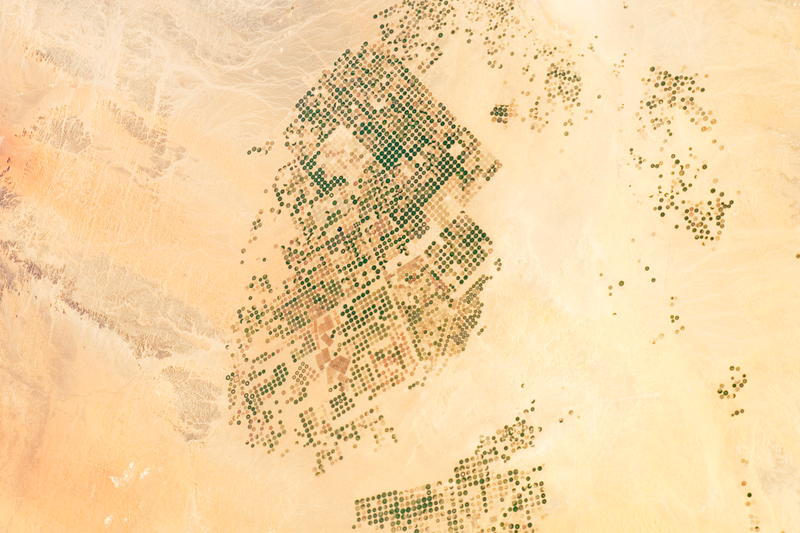File:Saudi Arabian agricultural fields.png
- Fichier
- Historique du fichier
- Utilisations locales du fichier
- Utilisations du fichier sur d’autres wikis
- Métadonnées

Fichier d’origine (1 440 × 960 pixels, taille du fichier : 2,08 Mio, type MIME : image/png)
Légendes
Légendes
Description
[modifier]| DescriptionSaudi Arabian agricultural fields.png |
English: Agricultural fields in the Wadi As-Sirhan Basin, Saudi Arabia. Taken by astronauts on the International Space Station.
|
||||||||||||||||||||||||||||||||||||||||||||||||||||
| Date | |||||||||||||||||||||||||||||||||||||||||||||||||||||
| Source | http://earthobservatory.nasa.gov/IOTD/view.php?id=77300 | ||||||||||||||||||||||||||||||||||||||||||||||||||||
| Auteur | Expedition 30 crew | ||||||||||||||||||||||||||||||||||||||||||||||||||||
| Autres versions |
|
||||||||||||||||||||||||||||||||||||||||||||||||||||
Conditions d’utilisation
[modifier]| Public domainPublic domainfalsefalse |
| Ce fichier provient de la NASA. Sauf exception, les documents créés par la NASA ne sont pas soumis à copyright. Pour plus d'informations, voir la politique de copyright de la NASA. |  | |
 |
Attention :
|
Historique du fichier
Cliquer sur une date et heure pour voir le fichier tel qu'il était à ce moment-là.
| Date et heure | Vignette | Dimensions | Utilisateur | Commentaire | |
|---|---|---|---|---|---|
| actuel | 16 avril 2012 à 02:57 |  | 1 440 × 960 (2,08 Mio) | BurtAlert (d | contributions) | {{Information |Description ={{en|1=Agricultural fields in the Wadi As-Sirhan Basin, Saudi Arabia. Taken by astronauts on the International Space Station.}} |Source =http://earthobservatory.nasa.gov/IOTD/view.php?id=77300 |Author =Exp... |
Vous ne pouvez pas remplacer ce fichier.
Utilisations locales du fichier
Les 2 pages suivantes utilisent ce fichier :
Utilisations du fichier sur d’autres wikis
Les autres wikis suivants utilisent ce fichier :
- Utilisation sur ar.wikipedia.org
- Utilisation sur bn.wikipedia.org
- Utilisation sur en.wikipedia.org
- User talk:LutherBlissetts
- Agriculture in Saudi Arabia
- User talk:Newyorkadam
- User talk:Ethraen
- User talk:PWNGWN
- User talk:Panpog1
- User talk:Teb00007
- User talk:Sahara4u/Archive 4
- User talk:Ryan115
- User talk:The boss 1998
- User talk:Simon Adler/Archive 1
- User talk:BluJay
- User:MrWooHoo/Archive 8
- User talk:CrawfordLou
- User talk:CryOCed
- User talk:Dominoooo's
- User talk:Timdwilliamson/AfI
- User talk:ChrisGualtieri/Archive 31
- User talk:CSJJ104/Archive 2
- User talk:GiantSnowman/2017
- User talk:HectorAE/Archive 4
- Wikipedia talk:Articles for improvement/Archive 21
- User talk:CookieMonster755/Archive/2017
- User talk:BabbaQ/Archive 4
- User talk:FR30799386/Archive 1
- User talk:Tom Morris/Archive 104
- User talk:CyberXRef/Archive 6
- User talk:Silver seren/Archive 20
- User talk:NorthwestPassage/Archive 2
- User talk:Theopolisme/Archive 26
- User talk:Presidentman/Archives/ 30
- User talk:Esquivalience/Archive 12
- User talk:Rystheguy/Archive 9
- User talk:Valereee/Archive 10
- User talk:Mahensingha/Archive 47
- User talk:Northamerica1000/Archive 77
- User talk:Chess/Archive 28
- User talk:MusikAnimal/Archive 38
- User talk:Stuartyeates/Archive 21
- User talk:KGirlTrucker81/Signpost/Archive 8
- User talk:Wikiuser13/Archive 47
- User talk:FULBERT/Archive 2
- User talk:K6ka/Archive 19
- User talk:Revi C./Archive 12
- User talk:Corinne/Archive 32
- User talk:Sam Sailor/Archive 18
- User talk:Quenhitran/Archive 31
Voir davantage sur l’utilisation globale de ce fichier.
Métadonnées
Ce fichier contient des informations supplémentaires, probablement ajoutées par l'appareil photo numérique ou le numériseur utilisé pour le créer.
Si le fichier a été modifié depuis son état original, certains détails peuvent ne pas refléter entièrement l'image modifiée.
| Résolution horizontale | 28,35 pt/cm |
|---|---|
| Résolution verticale | 28,35 pt/cm |

